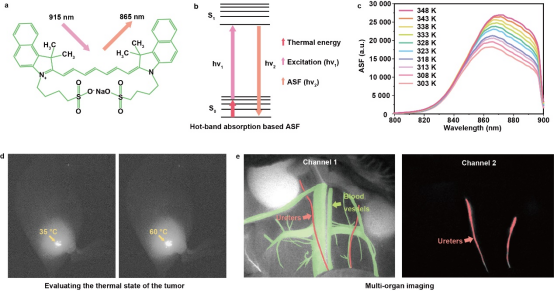Research Background
There are four common types of anti-Stokes fluorescence (ASF): (i) direct multiphoton absorption (MPA) process, (ii) upconversion (UC) process based on multistep absorption through intermediate energy levels, (iii) thermally activated delayed fluorescence (TADF) process, and (iv) hot-band absorption (HBA) process. The occurrence of MPA fluorescence generally requires extremely high excitation intensity and is usually achieved by using expensive femto- or pico-second pulsed lasers. UC processes in rare-earth ion doped nanoparticles (UCNPs), or triplet-triplet annihilation (TTA) based UC, can be obtained by using inexpensive continuous wave (CW) diode lasers. However, the absorption cross section of UCNPs is relatively small, resulting in low UC efficiency. TTA based metal complexes/organic compounds systems have larger absorption and higher quantum efficiency to be more efficient upconverters than UCNPs. Unfortunately, photostability of TTA based upconverters is relatively low due to strong quenching processes caused by molecular oxygen. TADF and HBA process in organic molecules excited by the CW laser are attractive anti-Stokes processes. What’s more, the potential of them to provide information about temperature in excited volume, makes them more attractive for application in bioimaging.
highlights
This paper discovered and studied the HBA based ASF in Food and Drug Administration (FDA)-approved Indocyanine Green (ICG). Based on thermal sensitivity, they applied ICG’s ASF for evaluating the thermal state of subcutaneous tumors of mice during photothermal treatment. Besides, ICG’s ASF is much stronger than typical UC fluorescence in UCNPs excited at 980 nm, with negligible thermal damage to biological tissues. Deep volume tomography of cerebral blood vessels and measurement of blood flow velocity of mice were performed by using the ASF of ICG. Moreover, in combination with L1057 nanoparticles (NPs), which absorb the ASF of ICG and emit beyond 1100 nm, these two probes generate multi-mode images in two fluorescent channels under the excitation of a single 915 nm CW laser. One channel is used to monitor two overlapping organs, urinary system and blood vessel of the rat, while the other shows urinary system only.

Summary
ICG could generate bright NIR ASF due to HBA under the excitation of CW laser at 915 nm. This ASF intensity is enhanced as temperature rises, and thus was utilized for monitoring the thermal state of subcutaneous tumors during photothermal treatments. Besides, the ASF of the certain ICG sample can be also used for the high-temperature indication (more suitable than its SF). Benefiting from its FDA-approved status, high emission efficiency even in the anti-Stokes mode of excitation, together with favorable excitation wavelength avoiding photothermal damage to biological tissues, and resistance to photobleaching, ICG shows promising applications in in vivo bioimaging fields, such as deep tomography of cerebral blood vessels and measurement of the blood flow velocity of the mouse. Furthermore, combining ICG with organic polymer dots, L1057 NPs, we achieved real-time advanced multi-mode bioimaging in vivo under a single CW light source excitation at 915 nm. This modality is very promising for intraoperative visualization which may help avoid accidental injury to adjacent blood vessels during clinical operations, and it can also be used for other clinical imaging scenes (e.g. identify lymphatic system and urinary system simultaneously).
Publishing Information:
Related results were published in " Light: Science & Applications " (PhD student Zhou Jing is the first author), [Jing Zhou, Xiaoxiao Fan, Di Wu, et al. Hot-band absorption of indocyanine green for advanced anti-stokes fluorescence bioimaging. Light: Science & Applications (2021). DOI: 10.1038/s41377-021-00627-1] The above work was funded by the National Natural Science Foundation of China, Fundamental Research Funds for the Central Universities and Zhejiang Provincial Natural Science Foundation of China.
Full paper download address:
https://doi.org/10.1038/s41377-021-00627-1






